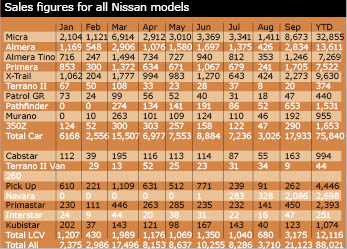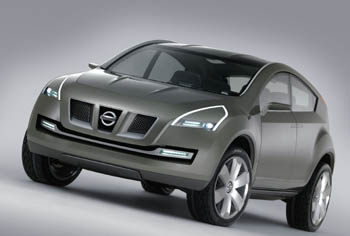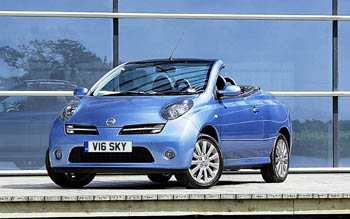New product has been the stimulant for this growth: Nissan has launched four cars so far this year (a fifth, the Micra C+C, is launched in November), each making a positive contribution in profit terms and as halo cars transforming the brand’s image.
Murano, 350Z Roadster and Pathfinder are far removed from the dull Primeras, Almeras and Sunnys of old. But, surprisingly, it’s been the Navara pick-up that has most excited retailers.
“That’s because they are selling so many, and it’s a rich mix,” says Simon Thomas, Nissan sales director. “Around 70% are top of the range models, and we expect to have sold 1,500-1,700 in September.”
This year, Nissan’s share of the new car market will be close to 4%; for LCVs it will be nearer 4.5%. That’s still a fair way behind the early Nineties’ highs, when new car shares topped 4.8%.
However, much of this was down to a double-digit share of the short-term rental market from which Nissan has since reduced its exposure. Short-term deals below 12 months now require a Nissan director’s sign off.
Its performance is still an improvement on three years ago when AM last took a good look at the brand. Then, the company had just hit a low point with market share the previous 12 months (2001) at 3.61%.
We speculated then that Nissan needed proper emphasis on image and sufficient investment in marketing support to ensure its cars were sought out rather than ending up on too many buyers’ ‘B’ lists.
#AM_ART_SPLIT# Muted impact of new models
This is being achieved, but the timing has been unfortunate. With a market down for the first time since 1999, the impact of Nissan’s new models has been, at first glance, slightly muted. However, without the four launches this year, dealers would be facing a sales slump arguably greater than the market’s overall 5% downturn.
They would have been forcing cars into the market in a futile attempt to hit volume targets, and profit margins would have disappeared. Instead, the average value of the cars retailers are selling has risen (by 20% since 2003), says Nissan, driving both turnover and profits.
Under the Value Up programme announced by Nissan chairman/CEO and new Renault boss Carlos Ghosn earlier this year, the company will launch 28 new models globally as it bids to raise sales to 4.2m by 2008. The UK gets 11 of these – Murano, 350Z Roadster, Pathfinder, Micra C+C and Navara are the first five – and several will be incremental, like the Qashqai crossover 4x4 due in 2007 (see panel).
Nissan’s new direction has been a wake-up call for dealers. They had been accustomed to managing a franchise where £10,000 Micras accounted for 40% of volume. This year’s launches have been in the £20,000-30,000 sector, a new territory with new conquest buyers.
Great for turnover and even better for margins, but it’s an area that requires a different approach to customer service. “Our dealers recognize that they have to try harder than the premium brands to meet the needs of customers because we do not have an established image in that part of the market,” says Thomas.
External showroom upgrades, including new signage and cladding, will be completed by the end of the year. Internal improvements, such as tiling and counter stands, will be finished next year. Nissan has also addressed the issue of dealer rewards, this year placing a much greater emphasis on CSI scores.
Dealers achieving good CSI can make 4% margins on cars, which, says Thomas, is driving the viability of the business by “putting the customer at the forefront and bonusing dealers accordingly”.
Across the network, profitability levels have slipped this year by 0.2%. Not ideal, but put in the context of other carmakers, that’s not a bad result – particularly when considering the level of investment dealers have made in the new corporate identity.
“Our evidence suggests that, across the franchises, profits are down on average by 0.5%,” adds Thomas. He expects an improvement next year as the revised bonuses structure really kicks in.
#AM_ART_SPLIT# Minimum performance
Average network profitability measurements have been dropped in favour of a minimum performance. The previous target was to average 1.6% return on sales, but that glossed over cracks at the edges. The spotlight has now been shifted to a 2% return on sales target for retailers that have been with the franchise for at least two years. The top half is achieving this; all 220 dealers must be by the end of 2007.
New dealers will be added and the network structure is being shuffled to fill an estimated 20 open points. Nissan is keen not to exceed 225 outlets and says that some smaller dealerships could be absorbed into neighbouring partners. “Units per outlet is key and this year it is down,” says Thomas. “But we want 20% growth over the Value Up period.”
To help fulfil its aspirations in new niches and against new competitors, Nissan has created a scorecard to benchmark the brand. Performance indicators include innovation, bold styling and a business matrix covering transaction prices versus rivals, against list price, and residual values.
Reversing out of short-term rental last year is having a positive impact on residuals. Its latest models compare favourably to sector leaders with, for instance, 350Z roadster residuals stepping on the heels of the Porsche Boxster and the Pathfinder matching the Land Rover Discovery.
This turnaround in residuals, combined with attractive new models, has given Nissan the confidence to tackle the contract hire market in earnest. Last year it doubled its penetration to 2% and over the summer it set up a field team with Nissan GB Finance to train dealers to sell funding products to businesses. This free service is a key tactic by which Nissan will raise its share of the contract hire market close to its 3.5% share of the retail market.
Nissan’s aspirations will not be achieved in a short timeframe. “It’s a 10-year job to get to where we want to be,” says Thomas.
“Brands are like the hour hand on a watch: they never seem to move while you are watching them. It’s only when you look back that you can see it has changed. Our brand has evolved and the momentum is building. We have made good progress.”


Sales peaked in the early Nineties, but then fell away as dull, uninteresting (though reliable) cars turned off buyers. Now on an upswing thanks to exciting new models
#AM_ART_SPLIT# New models

Qashqui Nissan’s crossover vehicle, now codenamed P32L, will spearhead a major sales push when it goes on sale in 2007. Nissan says it will compete against D and C segment cars, as well as SUVs.

Note On sale in March 2006, Note will sell 14,000 a year with pricing from £11,000 to £15,000. Four engines will be offered: 1.4 88bhp or 1.6 110bhp petrol and two 1.5dCi diesels (68bhp and 86bhp).

Micra C+C Due in November, the C+C is targeted to sell 20,000 cars. Its panoramic glass roof opens in just 22 seconds, while pricing starts at £13,150. Choice of 1.4- and 1.6-litre petrol engines.
#AM_ART_SPLIT# The analyst’s view
“We expect Nissan’s sales momentum to slow from Q3 2005 and to hit bottom in Q1 2006 because no new model launches are scheduled until summer 2006,” says Kunihiko Shiohara, Japanese automobile analyst at Goldman Sachs.
However, Shiohara then expects a “new product onslaught” that should push Nissan’s global sales to 4.2m units by 2008. That is based on the introduction of 10 new models and 18 model changeovers.
“Because of its late start with hybrids, the market has been sceptical of Nissan’s medium to long-term growth prospects. We think that Nissan will be able to close this competitive gap,” he says.
Yet Shiohara believes this has little impact on Nissan’s earning potential due to the limited market for hybrid models.
The retailer’s view
Crystal Motors has two Nissan dealerships in Lincolnshire, a solus dealership in Grantham and a dual site with Renault in Boston. It has held the franchise for two years and director and founder Mike Baldry has been impressed with the progressiveness of the brand.
“I think that it is a very positive brand and it has come on leaps and bounds in the last five years.
It now has one of the largest model ranges of any manufacturer and covers diverse niches with cars such as the 350Z and Pathfinder. We have a very good relationship with Nissan GB and the brand is proving very popular in our area with the 4x4 line-up, particularly the new Navara, selling well. With new products such as the Micra C+C and Tone soon to be launched, the future looks exciting.”












Login to comment
Comments
No comments have been made yet.